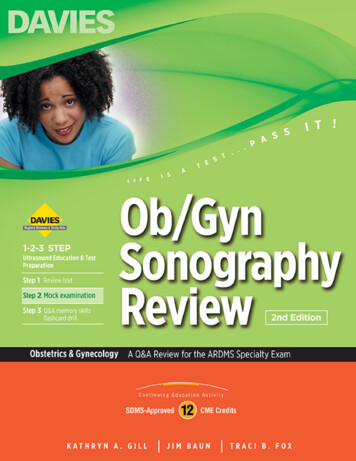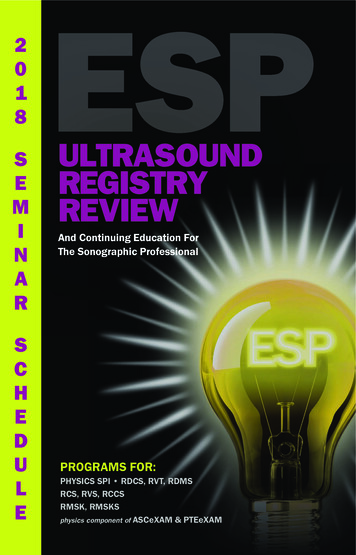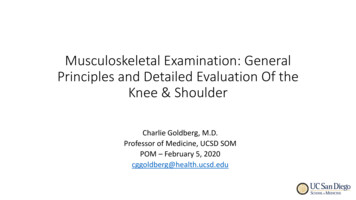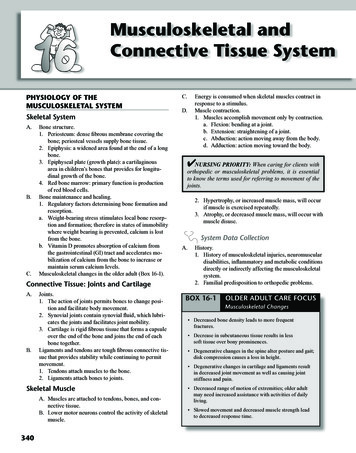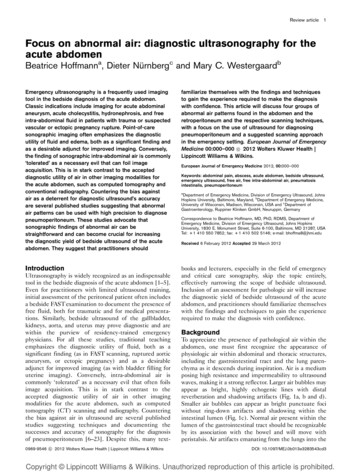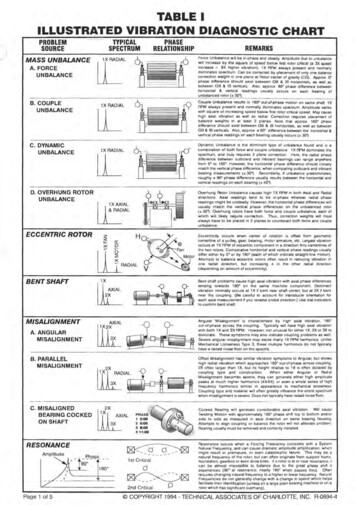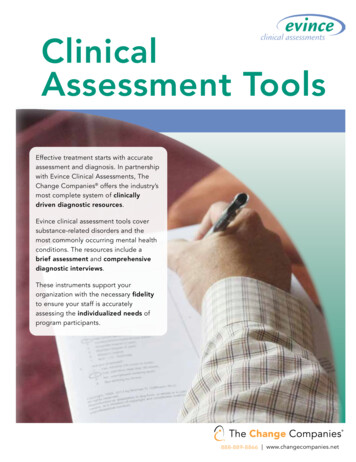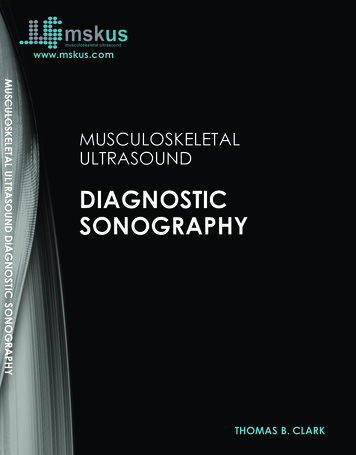
Transcription
www.mskus.comMUSCULOSKELETAL ULTRASOUND DIAGNOSTIC RAPHYTHOMAS B. CLARK
Handbook of Diagnostic UltrasoundTable of ContentsChapter 1 ShoulderAnteriorBiceps Tendon (short)Biceps Tendon (long)Pectoralis Major TendonDeltoid MuscleMedialCoracoacromial LigamentSubscapularis Tendon (long)Subscapularis Tendon (short)SuperiorA-C JointSubacromial ImpingementRotator CuffRotator Cuff (long)Rotator Cuff (short)Rotator Cuff IntervalPosteriorPosterior Glenohumeral JointSuprascapular Nerve in Infra Spinoglenoid NotchSuprascapular Nerve in Supra Spinoglenoid Notch3456789101112131415-161718Chapter 2 ElbowLateralLateral Epicondyle (long)Radial Humeral JointAnteriorDistal BicepsMedialUlnar Collateral LigamentMedial EpicondyleUlnar Nerve (short)PosteriorOlecranon Fossa (long)Olecranon Fossa (short)232425-262728293031Chapter 3 Wrist/HandFlexorFlexor Carpi RadialisMedian Nerve (short)Median Nerve (long)ExtensorExtensor CompartmentsDe Quervain’s Syndrome (1st compartment)Scapholunate LigamentTriangular Fibrocartilage ComplexHand1st CMC Joint3536373839404142
Handbook of Diagnostic UltrasoundTable of ContentsChapter 4 Hip/Pelvis/SpineAnteriorAnterior Hip JointPsoas TendonRectus Femoris TendonAdductor Longus (long)Lateral Femoral Cutaneous NervePosteriorPiriformisObturator InternusGreater Trochanter (short)SpineSacroiliac JointGreater Occipital Nerve (short)Greater Occipital Nerve (long)4748495051525354555657Chapter 5 KneeSuprapatellarQuadriceps TendonSuprapatellar PouchFemoral CondylesInfrapatellarPatellar Tendon (long)Patellar Tendon (short)MedialPatellofemoral LigamentMedial Collateral Ligament (long)Saphenous NervePes Anserine BursaLateralLateral Collateral LigamentPopliteus TendonIliotibial BandPosteriorBaker’s Cyst (long)Baker’s Cyst (short)Peroneal Nerve (short)616263646566676869707172737475Chapter 6 AnkleAnteriorAnterior Tibiofibular LigamentAnterior Talofibular LigamentDeep Peroneal NerveMedialPosterior Tibial TendonTibial NerveLateralPeroneus BrevisSural Nerve (short)Peroneus Longus Tendon (long)Subtalar Joint79808182-838485868788
Handbook of Diagnostic UltrasoundTable of ContentsChapter 6 AnklePosteriorAchilles Tendon (long)Achilles Tendon (short)Posterior Talotibial JointPlantarPlantar Fascia (long)Plantar Fascia (short)Foot1st MTP899091929394Chapter 7 Physics, Knobology, NomenclaturePhysics, Knobology, Nomenclature99
ShoulderBiceps Tendon (Short)Probe Position:short axis to biceps tendon within the bicipital groove and then scan caudally short axisslide of probe to the pectoralis major insertionPatient Position:patient seated on stool (facing US system preferred), affected upper arm aligned with torsoand elbow flexed 90 degrees and forearm supinated to align long head of biceps with humerusDoctor Position:sonographer seated on stool (facing US system preferred next to patient) with sonographer slightly elevated from patient (ergonomic)3
ShoulderRotator Cuff (Short)Probe Position:probe place 90 degrees from the rotatorcuff long probe position (point proberather than toward the navel rotate theprobe 90 degrees toward the patient’snose) (rotator cuff in short axis shouldappear with multiple septum that arepresent due to the three rotator cuff tendon sheaths and their central tendonshadows or “wagon wheel” appearance)Patient Position:seated on stool (backless stool is preferred so to not restrict arm position)with shoulder completely internallyrotated and extended (as far as patientcan without significant joint pain) aswell as elbow flexed so hand can reachpossibly to opposite back pocket (preferred shoulder position to exposerotator cuff from acromial shadow)Doctor Position:sonographer seated on stool (also facing US system preferred next to patient) with sonographer slightly elevated from patient (ergonomic)13
KneeBaker’s Cyst (Short)Probe Position:place the probe long axis to the criss crossof the semimembranosis and the medialgastrocnemius, proceed to rotate the probe90 degrees short axis to the semimembranosis tendon and medial gastrocnemiusmyotendinous junction (semimembranosis appears almost anechoic due to anisotrophy caused by the acute tendon fiber angle as it dives to its tibial insertion)Patient Position:patientpronewithasmallbolster or pillow under the anklesDoctor Position:doctor seated on exam stool on affected side of patient facing the head of theexam table and US system (usually USsystem on same side table as doctor)74
AnkleAchilles Tendon (Short)Probe Position:place the probe short axis over theAchilles tendon at the level of thecalcaneal insertion. Short axis linear slide the probe distally to visualizecalcaneal spurring and then short axis linear slide the probe proximally (cephalad)visualizing the retrocalcaneal bursa, Kager’sfat pad and myotendinous junction of thesoleus as it joins the Achilles (note the“winding” of the Achilles tendon fibers)Patient Position:patient prone with foot and ankle off the endof the table and foot moderately dorsiflexedDoctor Position:doctor seated on exam stool at the end of examtable and US system on the affectedsideoftheexamtable90
Hip/PelvisAnterior Hip JointProbe Position:probe placed long axis to theneck and head of femur, whichis approximately 30 degrees offmidline (4 o’clock on right or 8o’clock on left), on the inguinalfold at the mid point between thepubic symphysis and the ASIS(anterior superior iliac spine)Patient Position:patient supine with pillowder patients head but nolow or bolster underknee on the affectedunpilthesideDoctor Position:doctorstandingonaffected side facing head ofthe patient and US system47
ULTRASOUND DIAGNOSTIC SONOGRAPHY C THOMAS B. CLARK www.mskus.com. Handbook of Diagnostic Ultrasound Table of Contents Chapter 1 Shoulder Chapter 2 Elbow Anterior iceps Tendon (short)B iceps Tendon (long)B ectoralis Major TendonP eltoid MuscleD M

